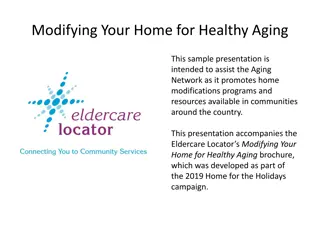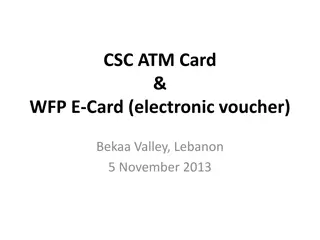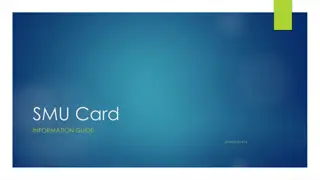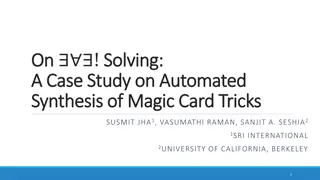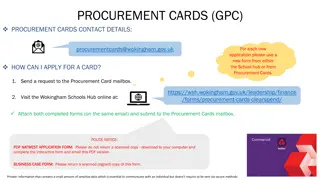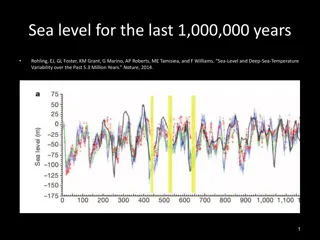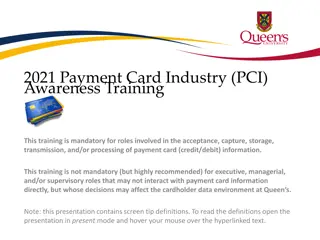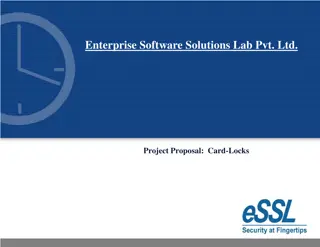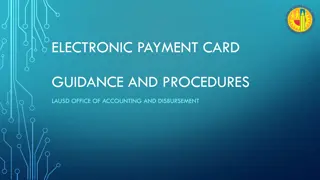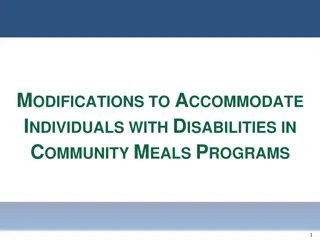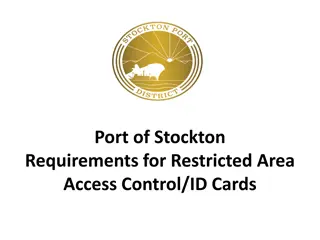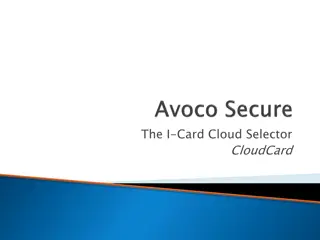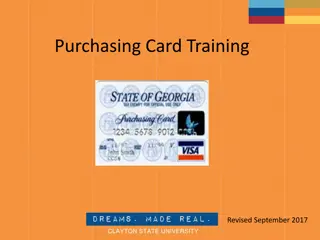Comprehensive Guide for Nucleotide Modifications Data Card in SEA Research
Nucleotide Modifications Data Cards are vital primary research records that document raw data generated by SEA researchers. The checklist ensures accuracy and interpretability when analyzing restriction digest fragment patterns. Follow the instructions for obtaining genomic sequences and comparing virtual and actual digest patterns for publication consideration.
Download Presentation

Please find below an Image/Link to download the presentation.
The content on the website is provided AS IS for your information and personal use only. It may not be sold, licensed, or shared on other websites without obtaining consent from the author. Download presentation by click this link. If you encounter any issues during the download, it is possible that the publisher has removed the file from their server.
E N D
Presentation Transcript
Nucleotide Modifications Data Card NUCLEOTIDE MODIFICATIONS DATA CARD Data Cards can serve as an essential primary research record for SEA research. They document the raw data generated by SEA researchers with enough information and analysis to be clear, interpretable, and useful to the broader SEA community.The following checklist indicates what is required for a Nucleotide Modifications Data Card to be accurate and interpretable. Please consult this guide throughout your research while planning experiments,as you collect data, and as you prepare and evaluate Data Cards Objective Objective: : Submitted data should allow for careful assessment of restriction digest fragment pattern to determine if the digest fragment pattern is the same as or different from the expected digest pattern for any given restriction enzyme DATACARD CHECKLIST The gel includes an appropriate DNA ladder. (NEB 1 kb Plus is recommended but can be substituted for a ladder that provides useful standard sizes for resolving expected band sizes on the gel.) The gel has been run such that ladder and sample bands are well-resolved. A good quality gel image is obtained with bands clearly visible. The gel lanes are appropriately separated and labeled with the name of the enzyme used and the observed digest pattern. *The samples should be loaded onto the gel such that the enzymes used are in alphabetical order as this is the way the enzyme tool will order the selected enzymes. The data card is completed with accurate information, including name of the phage, the cluster of the phage, the host bacterium, and the imaged and labeled gel and the corresponding virtual gel. The author card has the author information. The data description card describes the data, includes a brief description of the methodology, and any relevant references. This data card and sample data included were prepared by Dr. Gainey of Western Carolina University
NUCLEOTIDE MODIFICATIONS INSTRUCTIONS 1. For any phage that you have a good quality restriction enzyme digest gel image, obtain the complete genomic sequence from phagesDB 2. Visit https://tools.neb.com/REBsites/index.php and upload (or paste) a sequence file. Make sure linear, not circular, is selected. 3. In the bottom portion of the page in the Enzymes to use section, select these oligonucleotide sequences. 4. Enter the name and oligonucleotide sequence of the enzymes that were used to perform the digestion (top to bottom) as they appear on the gel from left to right. 5. Click submit, and a ~0.7% agarose gel containing a virtual digest of your bacteriophage s DNA will appear. 6. Take a screen shot of the virtual gel and add it to the template datacard Also add a photo of the actual (lab) digest gel to this datacard, making sure to label the actual digest gel with the enzymes used. template datacard provided at the end of this power point. 7. Compare the virtual digest to actual digest: For each enzyme used, label the top of the gel with one of the following digest patterns: E = expected digest pattern; I = impaired digest pattern, B = blocked digest pattern; U = uninterpretable NOTE: This can be tricky. For example, bands larger than 10kb can often not be distinguished from one another if run on a regular agarose gel and may therefore appear as one band on the gel. Also, bands that are smaller than 500bp are also not visible, due to that low percentage of agarose gels that we are running, and amount of DNA loaded (see example data slides). 8. Complete the data card, author cover card, and data description cards. Submit these cards to sea@hhmi.org for considerations for publication on QUBES as part of SEA Research.
SAMPLE DATA CARD WITH EXPECTED DIGEST PATTERN Bacteriophage Name: Bacteriophage Name: Adahisdi Cluster: Cluster: A1 Host Bacterium: Host Bacterium: Mycobacterium smegmatis NOTE: The BamHI pattern is expected because the top two fragments would not real gel due to their size (they will appear the same size as uncut), and the bottom fragment is too small to be seen. HindIII appears to be blocked, but upon closer inspection faint bands of the appropriate sizes can be seen. not be distinguishable on a Virtual Digest Virtual Digest Actual Digest Actual Digest Enzyme Used uncut BamHI ClaI EcoRI HaeIII HindIII Cut Pattern E E E E E E Ladder E = Expected I = Impaired B = Blocked
SAMPLE DATA CARD WITH BLOCKED DIGEST PATTERN Bacteriophage Name: Bacteriophage Name: Pabst Cluster: Cluster: EK1 Host Bacterium: Host Bacterium: Microbacterium foliorum NOTE: The NspI digest pattern is a clear example of a blocked pattern. None of the expected bands are present. Virtual Digest Virtual Digest Actual Digest Actual Digest Enzyme Used HaeIII NspI SacII Cut Pattern E B E ladder E = Expected I = Impaired B = Blocked
SAMPLE DATA CARD WITH IMPAIRED DIGEST PATTERN Bacteriophage Name: Bacteriophage Name: Eleri Cluster: Cluster: EA2 Host Bacterium: Host Bacterium: Microbacterium foliorum NOTE: The NspI digest pattern is impaired. Some fragments are present, but many more in the visible range are not. Virtual Digest Virtual Digest Actual Digest Actual Digest Enzyme Used HaeIII NspI SacII Cut Pattern E I E E = Expected I = Impaired B = Blocked
AUTHOR CARD Title: Title: Authors: Authors: Author Affiliations: Author Affiliations: Corresponding Author Email: Corresponding Author Email:
DATA CARD Bacteriophage Name: Bacteriophage Name: Cluster: Cluster: Host Bacterium: Host Bacterium: Actual Digest Actual Digest Virtual Digest Virtual Digest Enzyme Used Cut Pattern E = Expected I = Impaired B = Blocked
DATA DESCRIPTIONS CARD Description of Data and Observations: Description of Data and Observations: Replace this text with a brief description of your data and your interpretation Replace this text with a brief description of your data and your interpretation. . Methods: Methods: Replace this text with any deviations from the protocol for restriction digests or data analyses. Otherwise, state no no dev Replace this text with any deviations from the protocol for restriction digests or data analyses. Otherwise, state no no deviat iations for standard protocol ions for standard protocol References: References: Replace this text with any relevant references Replace this text with any relevant references


